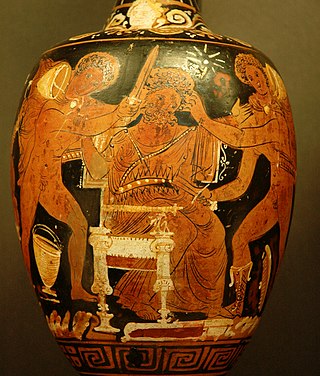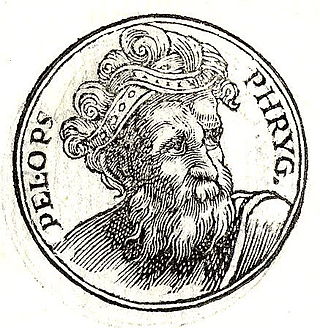Related Research Articles

In Greek mythology, Agamemnon was a king of Mycenae who commanded the Achaeans during the Trojan War. He was the son of King Atreus and Queen Aerope, the brother of Menelaus, the husband of Clytemnestra, and the father of Iphigenia, Iphianassa, Electra, Laodike, Orestes and Chrysothemis. Legends make him the king of Mycenae or Argos, thought to be different names for the same area. Agamemnon was killed upon his return from Troy by Clytemnestra, or in an older version of the story, by Clytemnestra's lover Aegisthus.

Aegisthus was a figure in Greek mythology. Aegisthus is known from two primary sources: the first is Homer's Odyssey, believed to have been first written down by Homer at the end of the 8th century BC, and the second from Aeschylus's Oresteia, written in the 5th century BC. Aegisthus also features heavily in the action of Euripides's Electra, although his character remains offstage.

Mycenae is an archaeological site near Mykines in Argolis, north-eastern Peloponnese, Greece. It is located about 120 kilometres south-west of Athens; 11 kilometres north of Argos; and 48 kilometres south of Corinth. The site is 19 kilometres inland from the Saronic Gulf and built upon a hill rising 900 feet above sea level.

In Greek mythology, Menelaus was a Greek king of Mycenaean (pre-Dorian) Sparta. According to the Iliad, the Trojan war began as a result of Menelaus’s wife, Helen, fleeing to Troy with the Trojan prince Paris. Menelaus was a central figure in the Trojan War, leading the Spartan contingent of the Greek army, under his elder brother Agamemnon, king of Mycenae. Prominent in both the Iliad and Odyssey, Menelaus was also popular in Greek vase painting and Greek tragedy, the latter more as a hero of the Trojan War than as a member of the doomed House of Atreus.
In Greek mythology, Atreus was a king of Mycenae in the Peloponnese, the son of Pelops and Hippodamia, and the father of Agamemnon and Menelaus. Collectively, his descendants are known as Atreidai or Atreidae.

In Greek mythology, Aerope was a Cretan princess as the daughter of Catreus, king of Crete. She was the sister to Clymene, Apemosyne and Althaemenes. Aerope's father Catreus gave her to Nauplius, to be drowned, or sold abroad, but Nauplius spared her, and she became the wife of Atreus, or Pleisthenes, and by most accounts the mother of Agamemnon and Menelaus. While the wife of Atreus, she became the lover of his brother Thyestes, and gave Thyestes the golden lamb, by which he became the king of Mycenae.

In Greek mythology, Thyestes was a king of Olympia. Thyestes and his brother, Atreus, were exiled by their father for having murdered their half-brother, Chrysippus, in their desire for the throne of Olympia. They took refuge in Mycenae, where they ascended the throne upon the absence of King Eurystheus, who was fighting the Heracleidae. Eurystheus had meant for their lordship to be temporary; it became permanent because of his death in conflict.
In Greek mythology, Pleisthenes or Plisthenes, is the name of several members of the house of Tantalus, the most important being a son of Atreus, said to be the father of Agamemnon and Menelaus. Although these two brothers are usually considered to be the sons of Atreus himself, according to some accounts, Pleisthenes was their father, but he died, and Agamemnon and Menelaus were adopted by their grandfather Atreus.

In Greek mythology, Pelops was king of Pisa in the Peloponnesus region. He was the son of Tantalus and the father of Atreus.

The Oresteia is a trilogy of Greek tragedies written by Aeschylus in the 5th century BCE, concerning the murder of Agamemnon by Clytemnestra, the murder of Clytemnestra by Orestes, the trial of Orestes, the end of the curse on the House of Atreus and the pacification of the Furies.

A Greek chorus in the context of ancient Greek tragedy, comedy, satyr plays, is a homogeneous group of performers, who comment with a collective voice on the action of the scene they appear in, or provide necessary insight into action which has taken place offstage. Historically, the chorus consisted of between 12 and 50 players, who variously danced, sang or spoke their lines in unison, and sometimes wore masks.

The Treasury of Atreus or Tomb of Agamemnon is a large tholos or beehive tomb constructed between 1300 and 1250 BCE in Mycenae, Greece.
In Greek mythology, Tantalus was a prince of the south of Argolis as son of King Thyestes. He was the brother of Pleisthenes. An alternative genealogy makes him the son of Broteas.
In Greek mythology, Thesprotus may refer to two individuals:

Thyestes is a first century AD fabula crepidata of approximately 1112 lines of verse by Lucius Annaeus Seneca, which tells the story of Thyestes, who unwittingly ate his own children who were slaughtered and served at a banquet by his brother Atreus. As with most of Seneca's plays, Thyestes is based upon an older Greek version with the same name by Euripides.
The mixing bowl with the exposure of baby Aegisthos is an ancient Greek ceramic calyx-krater, a bowl used for mixing wine and water. Manufactured in Taras in 330–320 BC, it is thought to be the only known artistic depiction of a lost play by Sophocles, Thyestes at Sikyon. It is currently on display in gallery 215C of the Museum of Fine Arts in Boston, Massachusetts, after having been purchased by them from Fritz Bürki and Son on February 25, 1987.

Agamemnon is a fabula crepidata of c. 1012 lines of verse written by Lucius Annaeus Seneca in the first century AD, which tells the story of Agamemnon, who was killed by his wife Clytemnestra in his palace after his return from Troy.
Thyestes is a lost tragedy by Euripides. The play may have concerned the myth of Thyestes' seduction of Aerope, the wife of his brother Atreus, and Atreus' subsequent revenge on Thyestes, killing his children and serving them to him at a feast.
Pleisthenes, in Greek mythology, was the son of Atreus and Aerope. According to Hesiod, Pleisthenes married Cleolla, daughter of Dias, and became the father of Agamemnon, Menelaus, and Anaxibia. Aeschylus also followed this tradition when he called the Atreidai "the race of Pleisthenes".
In Greek mythology, Pelopia, Pelopea or Pelopeia, less commonly known as Mnesiphae, was the daughter of Thyestes.
References
- Armstrong, Karen (2007). The Great Transformation: The Beginning of Our Religious Traditions. Random House Digital, Inc. ISBN 9780385721240.
- Parker, Robert (1983). Miasma : pollution and purification in early Greek religion. Oxford: Clarendon Press. ISBN 9780198147428.